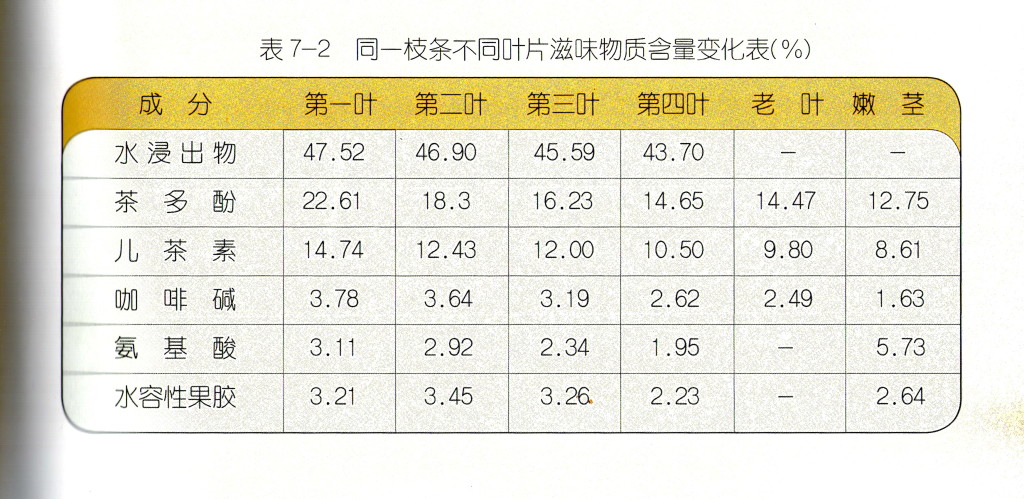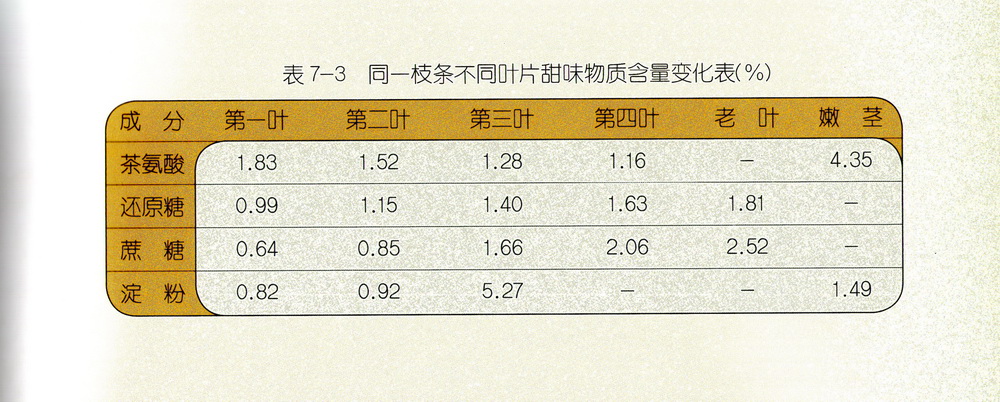There’s a bit of tea shop lore that says ” 一苦,二涩,三回甜/Yi ku, er si, san hui tian.” So ‘The first leaf is bitter, the second astringent, the third sweet.’
It seems like it’s true, but I was recently wondering if there was any scientific evidence to back it up. I was thumbing through a book I picked up a couple of years ago and found a discussion on the topic.*

Table of the variation in quantity of flavour producing compounds in same branch, different position leaves
Across the top of the table – is the leaf position: i.e. 1st leaf, 2nd leaf etc. with old leaves (lao ye) and (nen jing) supple stems at the right.
Down the left hand side are: dissolvable solids (水浸出物), polyphenols (茶多酚), catechins (儿茶素), caffeine (咖啡碱), amino acids (氨基酸) and water soluble sugars/pectin (水溶性果胶).
What the table shows is that polyphenols are highest in the first few leaves. The catechins are also highest in the 1st to 3rd leaves, caffeine is likewise highest in leaves 1-3, as are the amino acids.
If I might paraphrase, the author says “….Where the catechin and caffeine content in tea is relatively high, the liquor is full and refreshing, and is an indicator of high quality tea.
On a tea branch the level of polyphenols, caffeine, etc. is determined by the position of the leaf. The younger leaves have higher amounts of these bitter substances than older leaves, especially the first and second leaves after the bud. From there the levels of polyphenols, caffeine, etc, reduce.
Substances that cause astringence in tea are polyphenols, aldehydes, iron, and other compounds, of which catechins are particularly important.
The bitterness and astringency of ester type catechins (EGCG, ECG) is particularly strong. The content of these in the tip and first leaves is much higher than in older leaves.
Under normal circumstances, plucking a bud and one to two leaves will produce a tea with a much more bitter flavour than plucking three or four leaves. So, better quality tea that is picked more finely has a more bitter taste. It is also what makes poor quality tea taste relatively weak.”
The second table also has the same leaf position along the top, with theanine (茶氨酸), reduced sugars (还原糖), sugars/sucrose (蔗糖), and starch (淀粉) down the side.
What the second table shows is that the theanine is predominantly in the first and second leaf – with most in the young stems, reduced sugars and sucrose are predominantly in the 3rd and 4th, and older leaves (lao ye). Starch is markedly higher in the 3rd leaf.
Again, to paraphrase;
“There are three types of substances that produce a sweet flavour in tea:
1. Free monosaccharides and oligosaccharides such as: glucose,
galactose, fructose, rhamnose, maltose, sucrose, etc. which are the main compounds producing sweetness in tea.
2. Dissociative amino acids, such as: glycine, alanine, serine, threonine, proline and hydroxyl groups and those formed during tea processing: leucine, isoleucine, tryptophan, tyrosine acid, bitter alanine, methionine and valine.
3. Synthetic intermediates of catechins and dihydrochalcones and their derivatives and products of coumarin isomerization, etc.
The substances that cause sweetness in tea are more plentiful in spring and autumn tea, its taste is sweeter,richer with less bitterness and astringence, which makes it better than summer tea.
So looking at different leaves on the same branch, sucrose, sugars, etc, sweet substances are more abundant in old leaves than young leaves, and gradually increase with the age of the leaf.”
*Taken from ‘Deciphering Puer’ by Xu Ya He, published in 2006 by Yunnan Publishing Company/Yunnan Fine Arts Publishing.
** L theanine is believed to contribute to the ‘unami’ or brothy flavour of tea and is said to counter bitterness, as well as being attributed with other psychotropic effects, caused by raising levels of GABA Gamma-aminobutyric acid and dopamine.

